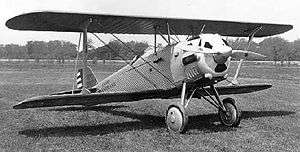Curtiss H-1640
| H-1640 | |
|---|---|
 | |
| A Thomas-Morse XP-13 Viper fitted with a Curtiss H-1640 Chieftain during testing | |
| Type | Radial aero engine |
| Manufacturer | Curtiss Aeroplane and Motor Company |
| First run | 1926 |
|
| |
The Curtiss H-1640 Chieftain was an unusual American 12-cylinder radial aero engine designed and built by the Curtiss Aeroplane and Motor Company in the mid-1920s.[1]
Design and development
The H-1640 was an air-cooled 12 cylinder two-row radial with the cylinder rows aligned rather than staggered as in most multi-row radials. One piece cylinder heads shared a single overhead camshaft and the propeller was directly driven. By aligning the cylinders the diameter of the engine was less than more conventional radial engines, and it was thought that the use of a Townend ring could make the engine more aerodynamically efficient than an inline engine. The engine first ran in 1927.
The H-1640 was the first airworthy 'inline radial' and was sponsored for flight testing in a range of aircraft by the U.S. Government. Among the types selected were the Thomas-Morse XP-13 and the Curtiss XO-18. Cooling problems with the rear cylinders caused the project to be canceled with few production engines being built.
A similar engine is the Bristol Hydra although this engine had 16 aligned cylinders, forming an octagon. Further similar engines are the Armstrong Siddeley Hyena and the much larger Armstrong Siddeley Deerhound.
Applications
Specifications (H-1640)
Data from enginehistory.org[2]
General characteristics
- Type: 12-cylinder, two-row, air-cooled radial engine
- Bore: 5⅝ in (142.9 mm)
- Stroke: 5½ in (139.7 mm)
- Displacement: 1,640 cu in (26.9 L)
- Diameter: 45 in (1,143 mm)
- Dry weight: 900 lb (408 kg)
Components
- Valvetrain: Overhead camshaft
- Fuel system: Single Stromberg NA-U8J carburetor
- Cooling system: Air-cooled
- Reduction gear: Direct drive, right-hand tractor
Performance
- Power output: 615 hp (459 kW)
- Specific power: 0.38 hp/cu in (17 kW/L)
- Power-to-weight ratio: 0.68 hp/lb (1.13 kW/kg)
See also
- Related lists
References
Notes
- ↑ Gunston 1989, p. 46
- ↑ Curtiss Chieftain www.enginehistory.org Retrieved: 17 September 2009
Bibliography
- Gunston, Bill. World Encyclopaedia of Aero Engines. Cambridge, England. Patrick Stephens Limited, 1989. ISBN 1-85260-163-9